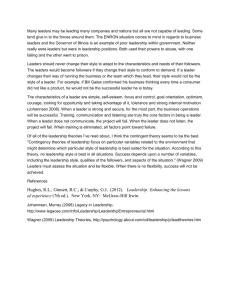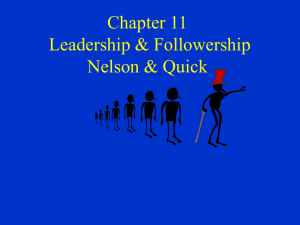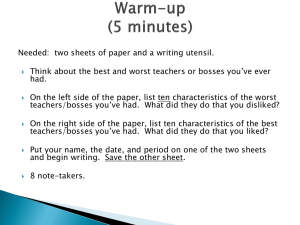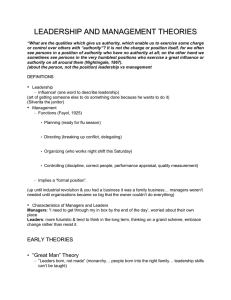Chapter 3 Personality, Perception, and Attribution Authors???
advertisement
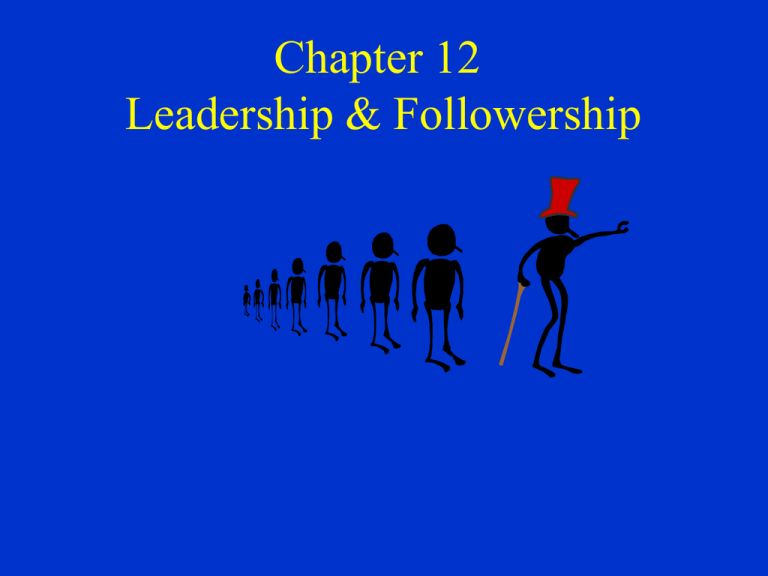
Chapter 12 Leadership & Followership Leadership & Followership Leadership - the process of guiding & directing the behavior of people in the work environment Formal leadership - the officially sanctioned leadership based on the authority of a formal position Informal leadership - the unofficial leadership accorded to a person by other members of the organization Followership - the process of being guided & directed by a leader in the work environment Leadership vs Management Leadership & management are distinct, yet complementary systems of action Effective management controls complexity Effective leadership produces useful change Effective leadership + good management = healthy organizations Management Process • Reduces uncertainty • Provides stability • Components – Planning & budgeting – Organizing and staffing – Controlling & problem solving Leadership Process • Creates uncertainty • Creates change • Components – Setting organizational direction – Align people with the direction via communication – Motivate people to action • Empowerment • Need gratification Leadership Theories • What is Leadership? – The ability to influence a group towards the achievement of goals. “We want all our leaders - from politicians to movie stars - to stir our souls a little, and we want the same thing from our managers. They have become the most significant figures in our society, with as central a role to play as generals, lords, oracles, or politicians played in centuries past, and we look to them for more than guidance.” T. Leal (1996). “Today, the subject of leadership is central to any discussion of the modern organization.” P. L. Brill, R. Worth (1997). “Great leaders don’t just ride waves, they make them.” W. Bennis (1996). Leadership Process Managers exercise leadership behavior to influence subordinates’ behavior to achieve goal directed results. Managers Perform Interpersonal, Informational, and Decision-Making Roles Role Description Examples Acts as a symbol or representative of the organization Performs diverse ceremonial duties Attends Chamber of Commerce meetings Heads the local United Way drive Represents the president of the firm at an awards banquet Leader Interacts with subordinates Motivates and develops employees Conducts quarterly performance interviews Selects training opportunities for subordinates Liaison Establishes a network of contacts to gather information for the organization Belongs to professional associations Meets over lunch with peers in other organizations Figure head (Cont.) Role Description Examples Gathers information from the environment inside and outside the organization Attends meetings with subordinates Scans company publications Participates in company wide committees Disseminator Transmits both factual and value information to subordinates Conducts staff meetings Sends memos to staff Meets informally with staff on a oneto-one basis to discuss current and future projects Monitor Spokesperson Gives information to people outside the organization about its performance and policies Oversees preparation of the annual report Prepares advertising copy Speaks at community and professional meetings (Cont.) Role Description Entrepreneur Designs and initiates changes in the organization Disturbance handler Resource allocator Negotiator Deals with problems that arise when organizational operations break down Controls the allocation of people, money, materials, and time Participates in negotiation activities Examples Redesigns the jobs of subordinates Introduces flexible working hours Brings new technology to the job Finds a new supplier on short notice for and out-of-stock part Replaces unexpectedly absent workers Deals with machine breakdowns Schedules his or her own time Programs subordinates’ work effort Prepares the budget Hires a new employee Determines compensation Specific Combinations of Roles Managerial Job Type Contact person Political manager Entrepreneur Key Roles Examples Liaison, figurehead Sales manager Chief executive in service industry Spokesperson, negotiator Top government, hospital, university manager Entrepreneur, negotiator Insider Resource allocator Owner of small, young business CEO of rapidly changing, large organization Middle or senior production or operations manager Manager rebuilding after crisis Leadership Theory Typology Degree of generalizability Leader attribute Universal Contingent Traits Type I Type III Behaviors Type II Type IV Reprinted by permission, A. G. Jago, “Leadership Perspectives in Theory and Research,” Management Science 22 (1982): 316. Copyright© 1982, The Institute of Management Sciences (currently INFORMS), 901 Elkridge Landing Road, Suite 400, Linthicum, Maryland 21090-2909 USA. Type I Universal Trait Theories of Leadership • Universal Trait theories - attempt to identify the traits &/or inherent attributes of leaders & the impact of these traits &/or styles on followers • Early Type I theories – focused on a leader’s physical attributes, personality, & ability • Current Type I theories – focus attention on the distinctions between leaders & managers – focus on charismatic leadership Transactional & Transformational Leadership As a transactional leader, I use formal rewards & punishments. As a transformational leader, I inspire and excite followers to high levels of performance. Leaders as Distinct Personalities Leader - an advocate for change & new approaches to problems Manager - an advocate for stability & the status quo Do not rock Leaders & Managers Personality Dimension Attitude toward goals Work conceptions Manager Leader Impersonal, passive, Personal, active functional Enabling processLooks for fresh combines people, ideas & approaches to old things problems Relationships Prefers to work with Comfortable in solitary others but avoids work, encourages closeness & conflict closeness, not conflict adverse Sense of self Born once, Twice born, struggles for straightforward life sense of life order, adjustment questions life Emergence of Women Leaders Gender • “A woman's place is in the House, ……… And in the Senate." Geraldine Ferraro • "Gender roles attitudes are shaped not only by social structural factor, but also by cultural factors, such as religious traditions.” Haller, 1994 Gender Differences? • Gender: Do Males and Females Lead Differently? – In general, women fall back on a democratic leadership style. – Men feel more comfortable with a directive style Charismatic Leadership • Charismatic leadership - the use, by a leader, of personal abilities & talents in order to have profound & extraordinary effects on followers • Charisma - gift in Greek • Charismatic leaders use referent power • Potential for high achievement & performance • Potential for destructive & harmful courses of action Transactional Leaders • Contingent Reward • Management by Exception • Laissez-Faire • Traditional Style of Leadership Characteristics of Charismatic Leaders • • • • • • Self-confidence Vision Ability to articulate the vision Strong convictions about the vision Behavior that is often out of the ordinary Perceived as being a change agent Transformational Leadership • • • • • Charisma Inspiration Vision Intellectual Stimulation Individualized Consideration Transactional vs Transformational • Transactional leaders guide or motivate their followers in the direction of established goals by clarifying role and task requirements. • Transformational leaders provide individualized consideration, intellectual stimulation, and possess charisma. • Transformational leadership builds on top of transactional leadership. Type II Universal Behavior Theories of Leadership • Universal behavior theories - discriminate the leaders’ actions from the followers’ perspective • Early Type II theories – classified leaders by style: autocratic, democratic, or laissez-faire • Current Type II theories – examine common behavior dimensions of all leaders – help organizations train & develop leaders rather than select them Leadership Style & Emotional Climate Autocratic style the leader uses strong, directive, controlling actions to enforce the rules, regulations, activities, & relationships in the work environment; followers have little discretionary influence Democratic style the leader takes collaborative, reciprocal, interactive actions with followers; followers have high degree of discretionary influence Laissez-fair style the leader fails to accept the responsibilities of the position; creates chaos in the work environment University of Michigan • Production Centered – emphasize technical or task aspects. • Employee Centered – emphasizing interpersonal relations. Leadership Behaviors – Ohio State Studies Initiating structure leader behavior aimed at defining & organizing work relationships & roles, as well as establishing clear patterns of organization, communications, & ways of getting things done Consideration - leader behavior aimed at nurturing friendly, warm working relationships, as well as encouraging mutual trust & interpersonal respect within the work unit The Ohio State Studies Suggested that Leaders High on Both Initiating Structure and Consideration Had the Best Outcomes MANAGER’S INITIATING STRUCTURE LOW HIGH HIGH LOW •High Performance •Low Performance •Low Grievance Rate •Low Grievance Rate •Low Turnover •Low Turnover •High Performance •Low Performance •High Grievance Rate •High Grievance Rate •High Turnover •High Turnover Leadership Styles in Japan P-oriented behavior • encourages a fast work pace • emphasizes good quality & high accuracy, • works toward highquantity production • demonstrates concern for rules & regulations M-oriented behavior • sensitive to employees’ feelings • emphasizes comfort in the work environment • works to reduce stress levels • demonstrates appreciation for follower contributions Source: Reprinted from “The Performance-Maintenance (PM) Theory of Leadership: Review of a Japanese Research Program by J. Misumi and M. F. Peterson published in Administrative Science Quarterly 30 (1985): 207 by permission of Administrative Science Quarterly © 1985. Managerial Grid High 1.9 Country club 8 management 9.9 Team management 9 Concern for People 7 6 5.5 Organization man management 5 4 Authorityobedience management 9.1 3 Impoverished management 1 1.1 2 “The Leadership Grid” from Leadership Dilemmas - Grid Solutions, by Robert R. Blake and Anne Adams McCanse. Huston: Gulf Publishing Company, p. 29. Copyright© 1991 by Scientific Methods, Inc. Reproduced by permission of the owners. Low 1 2 3 4 5 6 7 Concern for production 8 9 High Managerial Grid • Two Dimensions The Managerial Grid • Country Club Management – Thoughtful attention to needs of people for satisfying relationships leads to a comfortable friendly enterprise. • Impoverished Management – Exertion of minimum effort to get required work done is appropriate to sustain enterprise membership. • Middle-of-the-Road Management – Adequate enterprise performance is possible through balancing the necessity to get out work with maintaining morale of people at a satisfactory level. • Team Management – Work accomplishment is from committed people; interdependence through a “common stake” in enterprise objectives leads to relationships of trust and respect. • Authority-Obedience – Efficiency in operations results from arranging conditions of work in such a way that human elements interfere to a minimum degree. 9 Concern for People 8 7 9,9 Team Management Work accomplishment is from committed people, interdependence through a “common stake” in organization purpose leads to relationships of trust and respect. 1,9 Country Club Management Thoughtful attention to needs of people for satisfying relationships leads to a comfortable, friendly organization atmosphere and work tempo. 6 5 4 3 2 1 5,5 Organization Man Management Adequate organization performance is possible through balancing the necessity to get out work with maintaining morale of people at a satisfactory level. 9,1 1,1 Authority-Obedience Impoverished Management Efficiency in operations results Exertion of minimum effort to from arranging conditions of get required work done is apwork in such a way that human propriate to sustain organizaelements interfere to a minition membership mum degree. 1 2 3 4 5 6 7 Concern for Production 8 9 Type III Contingency Theories of Leadership • Contingency theories concerned with identifying the situationally specific conditions in which leaders with particular traits are effective • Central concern - how the leader leader’s traits interact with situational factors in determining team effectiveness in task performance situation Fiedler’s Contingency Theory Fiedler’s Contingency Theory - classifies the favorableness of the leader’s situation – leader’s position power - authority associated with the leader’s formal position in the organization – structure of the team’s task - degree of clarity, or ambiguity, in the team’s work activity – quality of the leader-follower (group members) interpersonal relationships – least preferred coworker (LPC) - the person a leader has least preferred to work with over his or her career Leadership Effectiveness in the Contingency Theory High LPC 1.00 relations oriented .80 Correlation between leader LPC & group performance .60 .40 .20 0 -.20 -.40 -.60 -.80 Low LPC task oriented Favorable for leader Leader-member relations Task structure Leader position power I II III IV V I G II G III G IV G S S Uns Uns Strong Weak Strong Weak VI VII Unfavorable for leader VIII V VI VII MPoor MPoor MPoor VIII Poor S Uns Uns Uns Strong Weak Strong Weak F. E . Fiedler, A Theory of Leadership Effectiveness (New York: McGraw-Hill, 1964.) Reprinted by permission. Vroom-Jago Model • Helps determine appropriate level of employee participation • Very practical means of assessing the situation • Five styles of Leadership Seven Questions • A -Is there a quality standard that makes one alternative superior to another • B -Do I have enough information to make a good decision • C -Is the problem structured? • D - Must workers accept my decision if they are to implement it effectively? • E - If I make the decision alone, are workers likely to accept my decision? • F - Do workers share the firm’s goals? • G - Is conflict among workers likely among preferred solutions? Path-Goal Theory of Leadership Leader behavior styles • Directive • Supportive • Participative • Achievement oriented Follower Characteristics • Ability level • Authoritarianism • Locus of control Follower path perceptions Effort-PerformanceReward linkages Workplace characteristics • Task structure • Work group • Authority system Follower goals • Satisfaction • Rewards • Benefits Path-Goal Theory • Environmental Contingency Factors – Task Structure – Formal Authority System – Work Group • Leader Behavior Factors – – – – Directive Supportive Participative Achievement-Oriented • Subordinate Contingency Factors – Locus of Control – Experience – Perceived Ability • OUTCOMES – Performance &/or Satisfaction Hersey-Blanchard Situational Leadership Model Leader’s concern with task Low High P. Hersey and K. H. Blanchard, Management of Organizational Behavior: Utilizing Human Resources, 3d ed., 1977, p. 170. Englewood Cliffs: Prentice Hall. High Leader’s concern with relationship Low Mature Employees Willing/Able Unwilling/able Willing/unable Unwilling/unable 4 3 2 1 Immature Employees Hersey & Blanchard Situational Leadership Theory • DIRECTIVE STYLE – A leadership style characterized by the giving of clear instructions and specific direction to immature employees. • COACHING STYLE – A leadership style characterized by expanding two-way communication and helping maturing employees build confidence and motivation. Situational Leadership cont. • SUPPORTING STYLE – A leadership style characterized by active two-way communication and support of mature employees' efforts to use their skills. • DELEGATION STYLE – A hands-off leadership style characterized by giving responsibilities for carrying out plans and making task decisions to the highly mature employees. Maturity or Readiness Level • Readiness Level One: Unable and unwilling or insecure -- Tell • Readiness Level Two: Unable but willing or confident -- Sell • Readiness Level Three: Able but unwilling or insecure -- Participate • Readiness Level Four: Able and willing or confident -- Delegate Guidelines for Leadership • Unique attributes, predispositions & talents of each leader should be appreciated • Organizations should select leaders who challenge but not destroy the organizational culture • Leader behaviors should demonstrate a concern for people; it enhances follower well-being • Different leadership situations call for different leadership talents & behaviors • Good leaders are likely to be good followers Five Types of Followers Independent, critical thinking Alienated followers Effective followers Survivors Passive Sheep Yes people Source: R. E. Kelley, “In Praise of Followers,” Harvard Business Review 66 (1988): 145. Independent, uncritical thinking Active Followership • • • • Warren Bennis Willingness to tell the truth - listening. Organizations benefit from diversity. Thoughtful dissent. Followership All organizations have far more followers than leaders, so ineffective followers may be more of a handicap to an organization than ineffective leaders. • What qualities do effective followers have? – They manage themselves well. – They are committed to a purpose outside themselves. – They build their competence and focus their efforts for maximum impact. – They are courageous, honest, and credible. Dynamic Follower • Responsible steward of his or her job • Effective in managing the relationship with the boss • Practices selfmanagement


